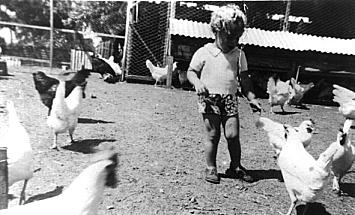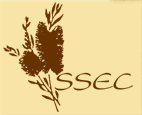Early Enterprises |
Fish Farm
Ducks
Many Kurnell people kept ducks, some for their own table and some for the city market. Mr Ducksbury (his actual name) had a small duck farm between Prince Charles Parade and Torres Street. There was also an establishment known as Taylor's Duck Farm, at the back of Marton Hall, off the end of Bridges Street, where the equestrian centre is located now. Mr Taylor, who kept bulldogs to guard the property also ran a seed business. Taylor's farm extended over to the south side of Solander Street. The ducks were raised for their eggs, their feathers for pillows and their delicate meat. The droppings were sold as fertiliser. George Blundell, owner of a series of ex-army blitz wagons, operated as a carrier and carted large crates of ducks to the markets, returning with feed and other produce. |
 |
Chooks
No Australian can call a chicken anything but a chook and many backyards had their chooks. Kurnell was no exception. Mrs Ingle, who had the honour of installing Kurnell's first windmill, had a poultry farm. So did the Honnor family, who kept a hundred chooks as well as running a shop, holiday houses and an apiary of several hundred hives. The honey was sold to Norco. John Graham Weir, who ran 400 chooks, was years ahead of his time with his organic garden, fertilised with seaweed in the backyard of his home which stretched between Torres Street and Prince Charles Parade. The Egg Board who bought his eggs regulated the poultry quota. Foxes were prevalent in the district and could wipe out scores of chooks in one night if they gained entry to a yard. Kurnell was still a 'farmy' place when the rest of the Sydney suburbs were being absorbed into a highly urbanised metropolis. |
 |
Wild Sheep and Pit Ponies
Thomas Holt had put sheep on his Kurnell land in 1868, a venture that ended in disaster, as described earlier. Surviving sheep were left to roam and became feral. In the 1930s there were still a few of them in the wilds of the headland and heath. They grew to a larger size than the normal farm animals, resembling wild goats rather than sheep according to an old resident who saw them as a child.
When coal mines at nearby Helensburgh and Wollongong needed pit ponies, John LeHane, one of the Shire's first councillors, devoted one of his farms at Caringbah to raising them. Apart from growing lucerne on the 'Highfields' (Caringbah) and grazing his cattle on agistment in the Captain Cook Landing Place Reserve, he capitalised on the need for the pit ponies, allowing them to roam throughout Kurnell feeding on its then plentiful fodder. The handwritten Reserve Trust records reveal that in March 1909 Thomas LeHane paid 25/2/9 (approx. $50) per quarter for his lease of grazing rights on the reserve. When the mines were mechanised there was no further need for these hardy horses. They were left on the peninsula to fend for themselves.
Roaming sheep, cattle and horses were prevented from wandering to Cronulla by a fence and gate located approximately where the Cronulla High School is today. |
| top of page |



